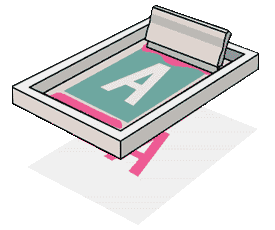During the 20th century the applications of the silkscreen technique has been largely commercial.
In order to indifferentiate creative silkscreen work from the more mundane purposes of that time the term serigraphy was derived. (Seri, latin for silk, and the Greek graphos, for write).
Because of the heavily commercial character the creative possibilities was rejected among artists for a long time. But later on, a considerable number of artists accepted the process for their own work and began to explore its particular characteristics.
Screen printing proved ideal for the aesthetic movements of the sixties; "Pop" art imagery and recognizable symbols of modern culture into new artistic statements; politics, "free" advertising and non commersial decoration.
Silkscreen is a non-expensive and easy way to set up workshops and a technique more accessible than any other print medium.

m o r e . . .